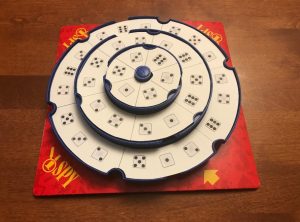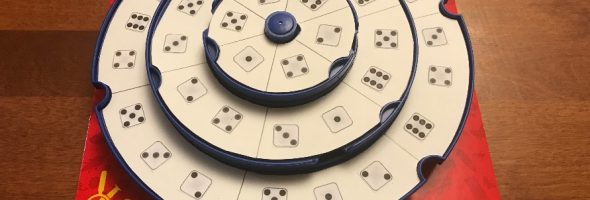Learning Object: I Spy
Fran Bailey

Would you like a game for your classroom that helps students practice number concepts through subitizing? Or a game that helps students recognize that fractions represent quantities? How about a game that involves multiplying (or dividing) fractions by single digit numbers? Your imagination is the limit as this game can be adapted to suit any Math unit in any grade. The inspiration for this game came from watching the Kristin Phillips TEDX talk on Spiraling the Curriculum (Spiraling Curriculum). To spiral the curriculum is to return to key concepts many times over the course of the year. Ms. Phillips speaks directly about the limitations of the current tendency to teach discrete concepts in a linear fashion, test the student’s knowledge and then move on to the next discrete lesson. She argues that if teachers allow students to practice certain math concepts many times over the course of the year their content retention is much higher. It struck me that this Math game could be a way to practice elements of the Math curriculum throughout the year. This Math game also supports spaced learning as students will gain increased ability and fluency with the subject as students play (practice) and then go on to other things (wait) and then play again (practice) another time.
This game is adapted from a game in my game cupboard called ‘I Spy’ (Appendix 1). The point of the game is to spin the apparatus and when the three plates lock into position all players try to find two similar objects within the designated play area defined by the arrow. The first person who finds two pictures that match gets to keep the corresponding card (and earns one point) and then the next player spins the game apparatus locking new images into the play area. I adapted this game to suit various Math curriculum objectives by changing the images on the apparatus to suit games involving various Math concepts. I will outline three possible Math games that cover three different areas and grade levels in the B.C. Curriculum but really, with a little thought, this game could be adapted to suit any Math lesson.
The first game I adapted involves subitizing, which is the ability to see and understand the number you are looking at without counting. I used images from dice faces because these dot configurations are familiar to students which is important when trying to subitize (Appendix 2).
Parts of the Grade 1 Curriculum that support the skill of subitizing include…
- Big Idea
- Numbers to 20 represent quantities that can be decomposed into 10s and 1s.
- Competencies and Content
- Number concepts to 20
- Addition and subtraction to 20 (understanding of operation and process)
- Explain and justify mathematical decisions
- Represent mathematical ideas in concrete, pictorial and symbolic forms
For the subitizing game, 2 – 4 students will take turns spinning the game board. When the three plates lock into position, the students quickly add one number from each plate within the play area as defined by the arrow, they then look for their ‘answer’ in the cards surrounding the board. The first person to grab their number card and be able to explain their strategy wins the card and the point. You can easily adapt this game into one that is more cooperative by having all of the students playing see how many different solutions they can make from one spin (and therefore how many different cards they can collect). The subitizing ‘problems’ posed by this game is an example of creating an ‘open task’, because it allows students to have choice in the numbers and strategies that they use to come up with an answer. You could give students further choice in this game by allowing them to choose between addition and subtraction or a combination of the two. As long as they can explain how they came to their final number, they get the card and the point. The explanation piece further supports math understanding as the students have to talk about the strategy they used. Variations in strategies between students are completely acceptable because the basic concept (addition or subtraction) is still being used. In fact, the variations in strategies are integral as they help students understand that there is more than one right way to get to a solution or to ‘see’ a problem.
A second game can be made to help students learn about fractions, a concept that is introduced in the Grade 3 curriculum. For this version, when the student spins the board and the three plates lock into place, the student simply chooses a fraction from the game board and finds its equivalent written fraction in the cards around the board (Appendix 3). The first student to match the game board fraction to the written fraction gets the card and the point. This helps students learn that the written fraction, which can seem somewhat abstract, actually represents the number of equal parts of the whole (as seen in the pictures). Again, the game can be adapted to be more cooperative by simply having students see how many of the written fractions they can find that match the drawn fractions on the board. This could also start to introduce the idea of equivalent fractions which is a concept introduced later in the curriculum.
Parts of the Grade 3 Curriculum that require knowledge of fractions
- Big Idea
- Fractions are a type of number that can represent quantities.
- Competencies and Content
- Develop, demonstrate, and apply mathematical understanding through play, inquiry, and problem solving
- Visualize to explore mathematical concepts
- Use mathematical vocabulary and language to contribute to mathematical discussions
- Represent mathematical ideas in concrete, pictorial, and symbolic forms
- fraction concepts
I think this game could even be adapted right up to the upper middle school level. In the three levels of the spinner, you could have single digit numbers represented by your dice pictures at the top and various examples of fractions on the lower two levels (Appendix 4). The player spins the game and then must multiply or divide a fraction chosen from the lower two levels by the single digit top number, represented by the dice picture. This extends operation fluency and understanding from whole numbers to fractions which is one of the Big Ideas in the Grade 8 Curriculum. This game could also be used as a Math Centre with a white board. It supports differentiation because students will choose to multiply or divide fractions according to their ability level.
Parts of the Grade 8 Curriculum that require knowledge of fractions
- Big Idea
- Computational fluency and flexibility extend to operations with fractions.
- Competencies and Content
- operations with fractions (addition, subtraction, multiplication, division, and order of operations)
- Demonstrate and apply mental math strategies
- Develop, demonstrate, and apply mathematical understanding through play, inquiry, and problem solving
- Explain and justify mathematical ideas and decisions
- Use mathematical vocabulary and language to contribute to mathematical discussions
Formative assessments can be done while you watch your students play this game. Just listening to your students as they play will give you a good idea of their level of understanding of the concept. As your students explain how they are using the game, including the strategies they are using to get the right answers, they will be practicing appropriate math language and vocabulary. A formative assessment in the younger grades could include taking a quick video of the students playing to add to Fresh Grade. The strategies students use during the games can be very informative with regards to how the students are approaching and thinking about the math problem and can help you as a teacher understand where student strengths and weaknesses are. This in turn can help you tailor future lessons to match student ability levels.
Appendix 1
This game is adapted from a game in my game cupboard called ‘I Spy’. 
I adapted this game to suit various Math curriculum objectives by changing the images on the apparatus to suit games involving various Math concepts.


Appendix 2
The first game I adapted involves subitizing, which is the ability to see and understand the number you are looking at without counting. I used images from dice faces because these dot configurations are familiar to students which is important when trying to subitize.

For the subitizing game, 2 – 4 students will take turns spinning the game board. When the three plates lock into position, the students quickly add one number from each plate within the play area as defined by the arrow, they then look for their ‘answer’ in the cards surrounding the board. The first person to grab their number card and be able to explain their strategy wins the card and the point.

Appendix 3
A second game can be made to help students learn about fractions, a concept that is introduced in the Grade 3 curriculum. For this version, when the student spins the board and the three plates lock into place, the student simply chooses a fraction from the game board and finds it’s equivalent written fraction in the cards around the board. The first student to match the game board fraction to the written fraction gets the card and the point.

Appendix 4
I think this game could even be adapted right up to the upper middle school level. In the three levels of the spinner, you could have single digit numbers represented by your dice pictures at the top and various examples of fractions on the lower two levels. The player spins the game and then must multiply or divide a fraction chosen from the lower two levels by the single digit top number, represented by the dice picture. This game could also be used as a Math Centre with a white board.


